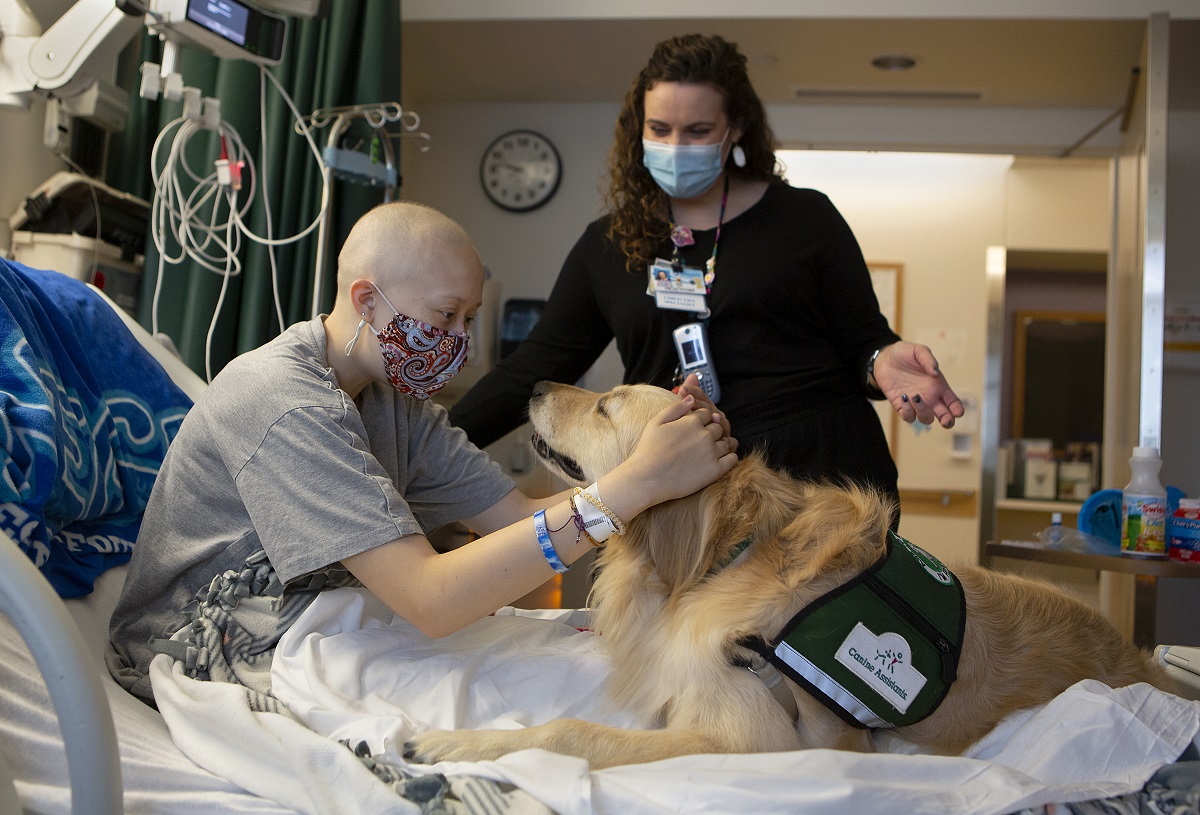Out of the dog house: Facility dogs return to work

Strolling past the elevators on the third floor of Penn State Health Children’s Hospital, Becky bumped into one of her favorite people.
Finding a Becky favorite isn’t a challenge. The golden retriever, one of two Child Life Services facility dogs, seems to love just about everyone.
In this case, the favorite was Sabriyyah “Bebe” Moutaabbid, a 12-year-old from Hanover, who was headed home from a short hospital stay. A few days ago, Bebe had had an allergic reaction to her chemotherapy.
Becky took a step toward her, tail wagging.
Bebe’s tiny voice climbed close to a register only Becky was capable of hearing.
“I’m leaving you,” Bebe squealed.
But, Becky seemed to protest, I just got here.
As Penn State Health works to emerge from COVID-19 restrictions, its four-legged therapists are gently nosing their way back through the doors as well. Becky and fellow facility dog Kaia arrived at work for the first time on June 16 after weeks at home.
“I wasn’t sure how she’d do,” said Erin Shaffer, a certified child life specialist and inpatient facility dog handler. At the end of every day, Becky goes home with Shaffer, and that’s where she waited out her quarantine.
Acclimating to the life of a dog of leisure was simple. “I have three boys who weren’t at school,” Shaffer said. “They kept her busy.”
In fact, the shift was so simple that Shaffer wasn’t sure how well her furry colleague would adjust to her old job.
Not to worry. From her first day back onward, Becky wasn’t phased. She greeted old friends with a tail wag or a nuzzle and has slowly begun getting back to her patients. New restrictions make sure it’s safe.
Though Becky isn’t required to don canine personal protective equipment, new rules for interacting with her are designed to protect patients and staff:
- People interacting with facility dogs must wash up or apply hand sanitizer first.
- Hallway/public area visits are limited to prevent group gatherings.
- No kisses or hugging. Petting only, please.
Facility dogs are different from Hershey’s therapy dogs, which are animals brought in by volunteers to help brighten patients’ days. Kaia and Becky are professionally trained, and while they aren’t above visiting someone in need of a pooch petting appointment, they perform specialized tasks to help their patients. For example, if a patient is anxious about equipment he or she might encounter during an exam, facility dogs can climb on tables or devices to prove there’s nothing to worry about.
Therapy dogs haven’t yet returned from COVID-19, yet.
The pandemic has changed Kaia’s and Becky’s jobs. Their interventions are now limited to 10 minutes or less. Everyone in the room – including the patient – must wear a mask. And neither dog will visit patients in isolation or during aerosol-generating procedures.
Shaffer guides Becky from place to place with a leash and collar made of material that can be wiped clean with sanitizing solution. Shaffer also cleans Becky’s uniform (the vest that lets people know she’s a staff member) and regularly wipes her paws.
After her visit with Bebe, Becky and Shaffer dropped by Emma Munger’s room. Like Bebe, the 14-year-old had also been admitted for an allergic reaction to her chemotherapy.
Becky climbed up on Emma’s bed. While the two cuddled, Shaffer asked Emma about her visit.
Becky rolled onto her side as Emma rubbed her fur.
“It won’t be so bad,” Emma said.
If you're having trouble accessing this content, or would like it in another format, please email Penn State Health Marketing & Communications.
